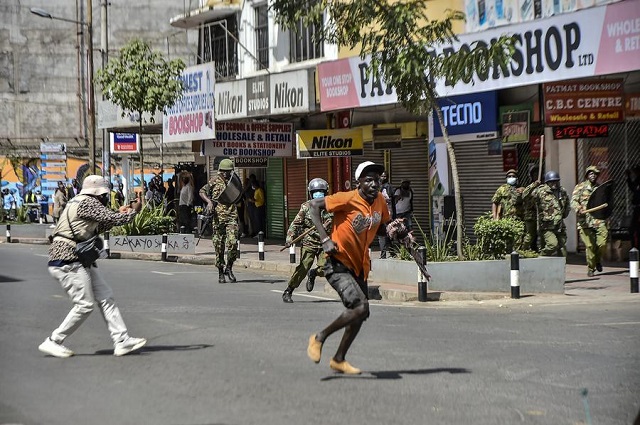
#OccupyParliament, #RejectFinanceBill are an opportunity for a new mode of emancipatory democracy
COMMENT | JOEL MUKISA | If you asked a think-tank team leader or a social sciences professor at Kabarak or Nairobi University if they anticipated the scale and popularity of the protests that rocked East Africa’s economic powerhouse Kenya recently for two weeks, they would possibly honestly say, no.
The protests that rather appeared spontaneous were characterised mainly by a young generation of Kenyans known as Gen Z protesting the Finance Bill (an annually produced document that lays out the government’s fiscal strategy) that would introduce a cocktail of new taxes on essential and basic commodities. The Bill was introduced in an economy recuperating from the COVID-19, Russia-Ukraine war supply chain shocks, a depreciating currency, massive debt and a divisive election.
The protests were characterised by incidents of violence, shootings by Kenya’s Police, deployment of the armed forces, deaths, looting, plunder and most dramatically, the setting of Parliament buildings ablaze.
This all came as a surprise; especially to Africanists that have viewed or touted Kenya as a radical break with what is steoreotypically African.
Kenya is characterised as democratically stable and having strong democratic institutions. So the force meted by Kenya’s police or even such rabid dissent with a leader of William Ruto’s stature and credentials can be confusing and hence a polycrisis. The tribeless protests can also not be understood under the banal templates of “ethnic madness.” This is why we must understand these protests as metaphors for something broader than what the protestors are proclaiming. This would be characteristic of contemporary social movements.
Nomeclature
Before we begin to understand the systemic shifts and questions the protest frothed, we should first understand it by the name under which it moves. The protests begun under the #OccupyParliament. Which was symbolic of the need to take a sovereign democratic institution and its symbolic power into the hands of the majority. This was after and slightly before parliament debated and passed the Finance Bill . Despite objections raised and wide mass distemper against the law, parliamentarians of the Kenya Kwanza (Governement) hurriedly passed the law with amendments from the minority in Parliament. Government claimed that it had listened and hence the amendments. The tone shifted with Gen Z clarifying that “Reject Not Amend.” The Amendment signalled the state’s ability to offer more if push came to shove that must urged those protesting to up the ante. And their gamble paid off when Kenya’s President William Ruto declined to ratify the impugned Bill sending it back to Parliament. It is in this context of democracy’s failure that #Ocuppy must be understood.
#Occupy is not a fresh lexicon onto the Antropocene. It first emerged in 2011 with the #OccupyWallStreet as a left wing anarchist movement against economic inequality, corporate greed and the influence of money in politics that had begun in Zuccotti Park, located in New York City’s Wall Street financial district, and lasted from September 17 to November 15, 2011. But we can better situate #OcuppyParliament without reducing it to an analogous analysis and rather steeping it within both its national, regional and international histriocity.
We can glean from the foregoing that, on the onset, #OcuppyMovements are mobilised online,they crumble and gloss over diffrences emanating from historical injuries such as race, tribe (in the African context) and class, gender( not so much) as bodies assemble on the streets to make the point that life is nolonger liveable.
These protests make known a hard truth that unity does not precede political praxis; it is produced through political struggle.
They bypass established democratic institutions that they think are part of the mess. They are leaderless hence less prone to compromise and represent a shift in ways of political organisation.
This spectre started in 1978 with the Soweto uprising that changed the conventional understanding of struggle from armed to popular struggle. Ordinary people stopped thinking of struggle as something waged by professional fighters, armed guerrillas, with the people cheering from the stands. It continues throughout Tahrir in 2011 when then-Egyptian president Hosni Mubarak was ousted. Little wonder the Kenya protesters hope that for their mission to be complete, Ruto too, must be ousted. That why, even after him ceding to their demands and refusing to sign the law, they are continue to protest under the hashtag #RutoMustGo.
The metaphor
CNN journalist Larry Madowo interviewed two people that have been subject of humour and caricature. He asked them why they were on the streets. What particular grievances they had against the state that perhaps prompted them to come to the streets? The answers shifted from incoherent and incomphrensible to muffled and inarticulate hinting at a systemic problem from which the Finance Bill is the immediate gab through which mass hysteria could be articulated.
Kenya is part of what has been termed as the African crisis or African Tragedy. The foregoing are adjectives for endemic poverty, high unemployement rates, inflation , corruption, deterioting terms of trade, cronynism and debt dependence.
These were in recent times compounded by the Corona Virus pandemic, a war in Ukraine, among an array of other international factors. In such a fix, with a near finacial crunch just pending, the kenyan leadership was forced into the IMF scrapbook for its striaghtjacket.
The IMF insists that the crises are budgetary i.e. that government expendintures have excedded revenues and the demand for foreign exchange outstripped supply. The short-term antidote is to freeze wages and cut social programs and subsidies. Secondly, increase production from the supply side by transfering resources from the classes which have a tendency to consume to those that have a tendecy to invest. The recommendations at times include regressive tax regimes on the middle class. A middle class that has been vanishing since 2008 during the Kibaki administration. Its this same middle class on whom the new taxes would be imposed. Joined by their dependant subaltern kith and kin on the streets in protests that were reminiscent of the 20th Century Bread Riots that too, opposed IMF and World Bank Austerity.
Kenya’s path on this neoliberal finacing model must be one of the most ambitious on the continent and has been sustained across decades without proper scrutiny of its nefarious cataclysmic implications such as the wide and dispropriate levels of income inequality that has been an enabler in the reproduction of a political caste or aristocracy from which “alternatives” in multi-party dispensations are to be chosen. The political economist Thandika Mkandwire refered to this as choiceless democracy given the restricted set of policy options available to African states, which find themselves strangled by a skewed international economic structure, the neoliberal economic and security demands of donors, and the pervasive presence of foreign NGOs and development agencies.
Therefore, the inarticulate protesters speak against this context of an all powerful elite and under an ever contracted political landlandscape that benefits a few. The concrete example should be how the opposition had fielded amendments to this regressive Bill in parliament that it later withdrew under the auspieces of a protest gaining momentum.
If the current state of democracy is limited in its scope to tuckle the pervasive issues that bedeevil us today and institutions of global economy such as IMF and World Bank remain unfazed as we stand in the hot African sun to elect leaders, then democracy as it has been sold to us has failed.
So do we #Ocuppy or continue reforming the political system to which this mess is greatly attributable. As Slavoj Zizek reminds us here, Marx’s key insight remains as pertinent today as it ever was: the question of freedom should not be located primarily in the political sphere – i.e. in such things as free elections, an independent judiciary, a free press, respect for human rights. Real freedom resides in the ‘apolitical’ network of social relations, from the market to the family, where the change needed in order to make improvements is not political reform, but a change in the social relations of production. We do not vote concerning who owns what, or about the relations between workers in a factory. Such things are left to processes outside the sphere of the political, and it is an illusion that one can change them by ‘extending’ democracy: say, by setting up ‘democratic’ banks under the people’s control.
The democractic illusion may thus be the real impediment to real time transfromation of the social relations of production and a beginging of convesations on politics of redistribution that has been supplanted by the discourse of recognition that has atomised emanicipatory struggles.
Ruto is not the problem, the problem is systemic and Kenyans should use this as an opportunity to search for a new mode of democracy that is emancipatory. To return to the start, the answer as to why no one would predict this kind of event is simple, it required imagination, a break with the past for which most social sciences are incapable. These protests should be understood in context with the recent events (coups) in West Africa that President Museveni has argued are a result of a stagnated economy and a youth bulge.
*****

Joel Mukisa is a researcher with interests in political economy, agrarian question, human rights, philosophy and psycho-analysis
 The Independent Uganda: You get the Truth we Pay the Price
The Independent Uganda: You get the Truth we Pay the Price



